Wai-Fah Chen.The Civil Engineering Handbook
Подождите немного. Документ загружается.

IV
-4
The Civil Engineering Handbook, Second Edition
Both in surface water and groundwater hydrology, recent researchers have been inspired by the
improved ability to observe and model the many heterogeneities of surface and material properties and
of transport processes (van Genuchten 1991). Remote sensing now makes it possible to model land
surface hydrologic processes at the global scale. Then these processes can be included in general circulation
models of the atmosphere (Wood 1991). The research accomplishments in surface water and groundwater
hydrology are summarized every 4 years in reports from several countries to the International Union of
Geodesy and Geophysics. The U.S. quadrennial report is prepared by the American Geophysical Union
and is published in
Reviews of Geophysics.
Similarly, in coastal engineering, recent mathematical models make it possible to simulate large-scale
coastal behavior that is at scales larger than tens of kilometers and time scales of decades. These models
include waves, currents, and sediment transport. Models capable of describing the interaction with the
bottom topography are under development at least for short-term coastal behavior (De Vriend 1991,
Holman 1994). The new techniques mentioned in the previous paragraphs are still in the research stage
and are beyond the scope of this handbook, but the references at the end of this introduction provide
entry points into several research fields.
References
Abbott, M.B., 1994. Hydroinformatics: a Copernican revolution in hydraulics,
J. Hydraulic Res.
, vol. 32,
pp. 1–13, and other papers in this special issue.
Abbott, M.B., Babovic, V.M. and Cunge, L.A., 2001. Towards the hydraulics of the hydroinformatics era,
J. Hydraulic Res.,
vol
.
39, pp. 339–349.
De Vriend, H.B., 1991. Mathematical modelling and large-scale coastal behavior,
J. Hydraulic Res.
, vol.
29, pp. 727–755.
Holman, R., 1994. Nearshore processes, in U.S. National Report to the International Union of Geodesy
and Geophysics 1991–1994,
Rev. Geophys.,
supplement, part 2
,
pp 1237–1248.
Kutija, V. and Hong, 1996. A numerical model for assessing the additional resistance to flow induced by
flexible vegetation,
J. Hydraulic Res.,
vol. 34(1), pp. 99–114.
Starosolski, O. 1991. Hydraulics and the environmental partnership in sustainable development,
J. Hydraulic Res.
, vol. 29 and other papers in this extra issue.
van Genuchten, M.T. 1991. Progress and opportunities in hydrologic research, 1987–1990, in U.S.
National Report to the International Union of Geodesy and Geophysics 1991–1994,
Rev. Geophysics
,
supplement, April 1991, pp. 189–192.
Watkins Jr., D.W. and McKenney, D.C. 1994. Recent developments associated with decision support
systems in water resources, in U.S. National Report to the International Union of Geodesy and
Geophysics 1991–1994,
Rev. Geophysics,
supplement,
part 2
,
pp. 941–948.
Wood, E.F., 1991. Global scale hydrology: advances in land surface modelling
,
in U.S. National Report
to the International Union of Geodesy and Geophysics 1987–1990,
Rev. Geophysics,
supplement,
pp. 193–201.
© 2003 by CRC Press LLC

© 2003 by CRC Press LLC
29
Fundamentals
of Hydraulics
29.1 Introduction
29.2 Properties of Fluids
Fluid Density and Related Quantities • Fluid Viscosity and
Related Concepts • The Vapor Pressure • The Bulk Modulus
and the Speed of Sound • Surface Tension and Capillary Effects
29.3 Fluid Pressure and Hydrostatics
Hydrostatics • Forces on Plane Surfaces • Forces on Curved
Surfaces
29.4 Fluids in Non-Uniform Motion
Description of Fluid Flow • Qualitative Flow Features and Flow
Classification • The Bernoulli Theorem
29.5 Fundamental Conservation Laws
Fluxes and Correction Coefficients • The Conservation
Equations • Energy and Hydraulic Grade Lines
29.6 Dimensional Analysis and Similitude
The Buckingham-Pi Theorem and Dimensionless Groups •
Similitude and Hydraulic Modelling
29.7 Velocity Profiles and Flow Resistance in Pipes and
Open Channels
Flow Resistance in Fully Developed Flows • Laminar Velocity
Profiles • Friction Relationships for Laminar Flows • Turbulent
Ve locity Profiles • Effects of Roughness • Friction Relationships
for Turbulent Flows in Conduits • Minor Losses
29.8 Hydrodynamic Forces on Submerged Bodies
The Standard Drag Curve
29.9 Discharge Measurements
Pipe Flow Measurements • Open-Channel Flow Measurements
29.1 Introduction
Engineering hydraulics is concerned broadly with civil engineering problems in which the flow or
management of fluids, primarily water, plays a role. Solutions to this wide range of problems require an
understanding of the fundamental principles of fluid mechanics in general and hydraulics in particular,
and these are summarized in this section.
D. A. Lyn
Purdue University

29
-2
The Civil Engineering Handbook, Second Edition
29.2 Properties of Fluids
The material properties of a fluid, which may vary, sometimes sensitively, with temperature, pressure,
and composition (if the fluid is a mixture), determine its mechanical behavior. The physical properties
of water and other common fluids are given in Tables 29.1 to 29.7 at the end of this chapter.
Fluid Density and Related Quantities
The density of a fluid, denoted as
r
, is defined as its mass per unit volume with units kg/m
3
or slug/ft.
3
The
specific gravity
, denoted as
s
, refers to the dimensionless ratio of the density of a given material to
the density of pure water,
r
ref
, at a reference temperature and pressure (often taken to be 4
∞
C and
1 standard atmosphere): s
∫
r
/
r
ref
. The
specific weight
, denoted as
g
, is the weight per unit volume, or
the product of
r
and
g
, the gravitational acceleration:
g
r
g
.
Fluid Viscosity and Related Concepts
Fluids are
Newtonian
if their strain rate is linearly proportional to the applied shear stress, and is zero
when the latter is zero. The strain rate can be related to gradients of fluid velocity. The proportionality
constant is the
dynamic viscosity
, denoted by
m
, with units N s/m
2
or lb s/ft.
2
Frequently
m
arises in
combination with
r
, so that a
kinematic viscosity
, defined as
n
m
/
r
, with units m
2
/s or ft
2
/s, is defined.
Some materials, e.g., mud, may, under certain circumstances, behave as fluids but may not exhibit such
a relationship between shear stress and the strain rate. These are termed
non-Newtonian fluids
. The most
common fluids, air and water, are Newtonian. Because the values of
m
for common fluids are relatively
small, the concept of an
ideal fluid
, for which
m
= 0, is useful; effects of fluid friction (shear) are thereby
neglected. This approximation is not valid in the vicinity of a solid boundary, where the
no-slip condition
must be satisfied, i.e., at the fluid-solid interface, the velocity of the fluid must be equal to the velocity
of the solid surface.
The Vapor Pressure
The
vapor pressure
of a pure liquid, denoted as
p
v
, with units Pa abs or lb/ft
2
abs (abs refers to the absolute
pressure scale, see Section 29.3), is the pressure exerted by its vapor in a state of vapor-liquid equilibrium
at a given temperature. It derives its importance from the phenomenon of
cavitation
, the term applied
to the genesis, growth, and eventual collapse of vapor bubbles (cavities) in the interior of a flowing liquid
when the fluid pressure at some point in the flow is reduced below the vapor pressure. This leads to
reduced performance and possibly damage to pumping and piping systems and spillways.
The Bulk Modulus and the Speed of Sound
The
bulk modulus of elasticity
, denoted by
E
v
, is the ratio of the change in pressure,
p
(see Section 29.3)
to the relative change in density:
E
v
=
r
∂
p
/
∂
r
, with units Pa or lb/ft,
2
and measures the compressibility
of a material. Common fluids such as water and air may generally be treated as
incompressible
, i.e.,
E
v
Æ
•
.
Compressibility effects become important, however, where large changes in pressure occur suddenly, as
in
waterhammer
problems resulting from fast closing valves, or where high speeds are involved as in
supersonic flow. The kinematic quantity, the speed of sound, defined by
c
= , may be more
convenient than
E
v
to use.
Surface Tension and Capillary Effects
The interface between immiscible fluids acts like an infinitely thin membrane that supports a tensile
force. The magnitude of this force per unit length of a line on this surface is termed the
coefficient of
surface tension
, denoted as
s
, with units N/m or lb/ft. Effects of surface tension are usually important
E
v
r§
© 2003 by CRC Press LLC
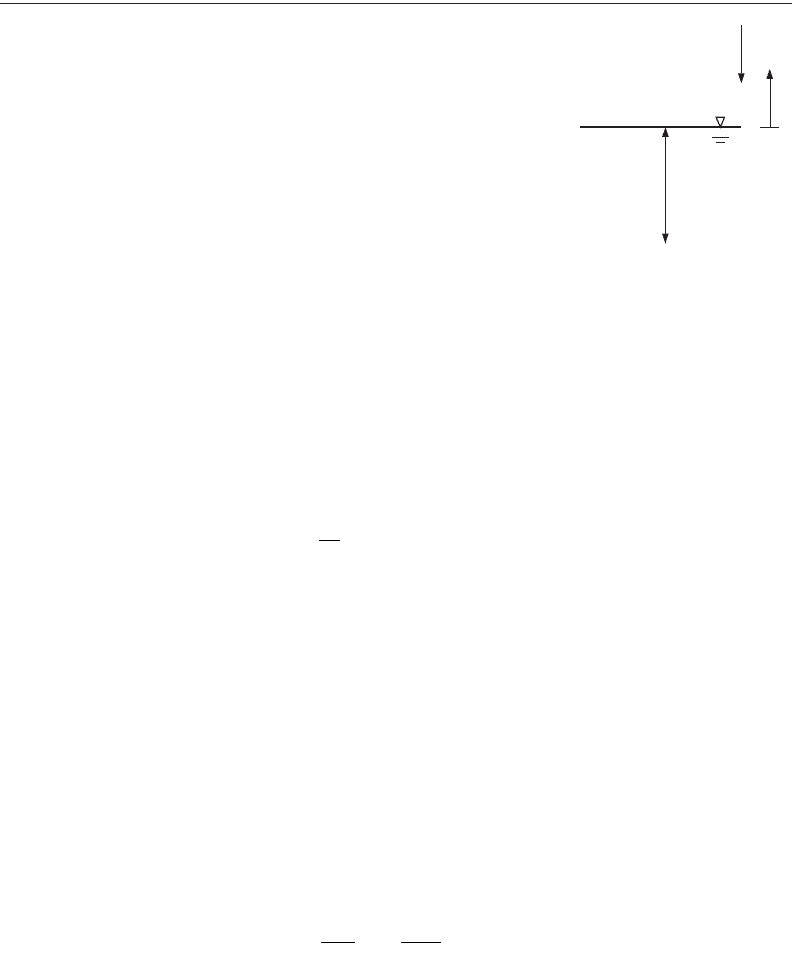
Fundamentals of Hydraulics
29
-3
only for problems involving highly curved interfaces and small length scales, such as in small-scale
laboratory models.
Capillary
effects refer to the rise or depression of fluid in small-diameter tubes or in
porous media due to surface tension. The value of
s
varies with the fluids forming the interface, and is
affected by chemically active agents (surfactants) at the interface.
29.3 Fluid Pressure and Hydrostatics
Pressure in a fluid is a normal compressive stress. It is considered
positive even though compressive, and its magnitude does
not
depend
on the orientation of the surface on which it acts. In most practical
applications, pressure differences rather than absolute pressures are
important because only the former induce net forces and drive flows.
Absolute pressures are relevant however in problems involving cav-
itation, since the vapor pressure (see Section 29.2) must be consid-
ered. A convenient pressure scale, the
gage pressure scale
, can be
defined with zero corresponding to atmospheric pressure,
p
atm
, rather
than an
absolute pressure scale
with zero corresponding to the pressure
in an ideal vacuum. The two scales are related by
p
gage
=
p
abs
–
p
atm
.
At the free surface of a water body (Fig. 29.1) that is exposed to the
atmosphere, p
gage
= 0, since p
abs
= p
atm
. Unless otherwise specified,
the gage pressure scale is always used in the following.
Hydrostatics
Hydrostatics is concerned with fluids that are stagnant or in uniform motion. Relative motion (shear
forces) and acceleration (inertial forces) are excluded; only pressure and gravitational forces are assumed
to act. A balance of these forces yields
, (29.1)
which describes the rate of change of p with elevation z, and where the chosen coordinate system is such
that gravity acts in a direction opposite to that of increasing z (Fig. 29.1). In Eq. (29.1), r or g may vary
in the z-direction, as is often the case in the thermally stratified atmosphere or lake. Where r or g is
constant over a certain region, Eq. (29.1) may be integrated to give
(29.2)
which indicates that pressure increases linearly with depth.
Only differences in pressure and differences in elevation are of consequence, so that a pressure datum
or elevation datum can be arbitrarily chosen. In Fig. 29.1, if the elevation datum is chosen to coincide
with the free surface, and the gage pressure scale is used, then the pressure at a point, A, located at a
depth, h, below the free surface (at z = –h), is given by p
A
=
g
h. If g ª 0, as in the case of gases, and
elevation differences are not large, then p ª constant. Eq. (29.2) can also be rearranged to give
(29.3)
The piezometric head with dimensions of length is defined as the sum of the pressure head, p/g, and the
elevation head, z. Equation (29.3) states that the piezometric head is constant everywhere in a constant-
density fluid where hydrostatic conditions prevail.
FIGURE 29.1 Pressure scales and
coordinate system for Eq. (29.1).
z
gage
p
= 0
(
p = p
abs atm
)
atmosphere
h
A
g
dp
dz
zg z=- =-rg() ()
pz pz z z() ( ) ( )-=--
00
g
pz
z
pz
z
()
()
gg
+= +
0
0
© 2003 by CRC Press LLC
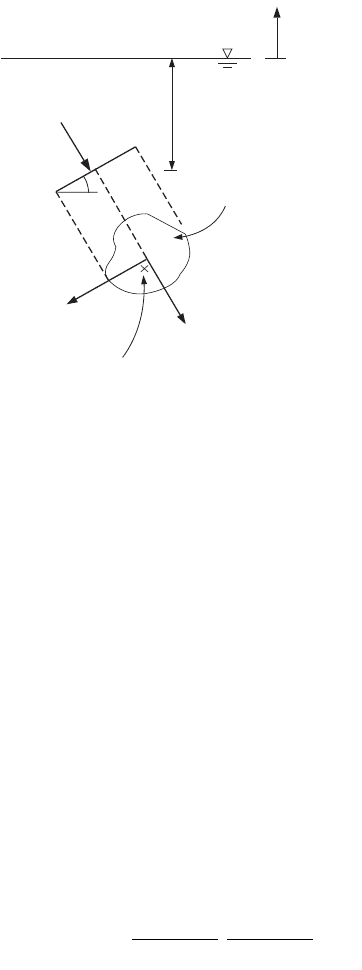
29-4 The Civil Engineering Handbook, Second Edition
Forces on Plane Surfaces
The force on a surface, S, due to hydrostatic pressure is obtained by integration over the surface. If the
surface is plane, a single resultant point force can always be found that is mechanically equivalent to the
distributed pressure load (Fig. 29.2). For the case of constant-density fluid, the magnitude of this resultant
force, F, may be determined from
(29.4)
where p
c
= p
0
+
g
h
c
is the pressure at the centroid of the surface, situated at a depth, h
c
, and A is the area
of the surface. Because p
c
= F/A, it is interpreted as the average pressure on the surface.
This resultant point force acts compressively, normal to the surface, through a point termed the center
of pressure. If the surface is inclined at an angle, q, to the horizontal, the coordinates of the center of
pressure, (x
cp
, y
cp
), in a coordinate system in the plane of the surface, with origin at the centroid of the
surface, are
(29.5)
where I
xx
is the area moment of inertia, I
xy
the product of inertia of the plane surface, both with respect
to the centroid of the surface, and y is positive in the direction below the centroid.
The properties of common plane surfaces, such as centroids and moments of inertia, are discussed in
the section on mechanics of materials. The surface is often symmetrically loaded, so that I
xy
= 0, and
hence, x
cp
= 0, or the center of pressure is located directly below the centroid on the line of symmetry.
If the surface is horizontal, the center of pressure coincides with the centroid. Further, as the surface
becomes more deeply submerged, the center of pressure approaches the centroid, (x
cp
, y
cp
) Æ (0,0),
because the numerators of Eq. (29.5) remain constant while the denominator increases (p
c
increases).
FIGURE 29.2 Hydrostatic force on a plane surface.
O
z
p = p
0
x
y
h
c
F
center of pressure
(x , y )
cp cp
θ
surface on
which F acts
O =
centroid of
surface
FpdSpA
c
s
==
Ú
xy
I
F
I
F
cp cp
xy
xx
,
sin
,
sin
()
=
()
()
È
Î
Í
Í
˘
˚
˙
˙
gq
gq
© 2003 by CRC Press LLC
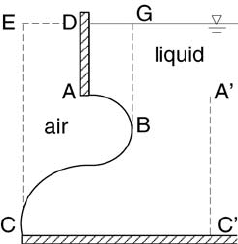
Fundamentals of Hydraulics 29-5
For plane surfaces that can be decomposed into simpler elementary surfaces, the magnitude of the
resultant force can be computed as the vector sum of the forces on the elementary surfaces. The coordinates
of the center of pressure of the entire surface are then determined by requiring a balance of moments.
Forces on Curved Surfaces
For general curved surfaces, it may no longer be possible to deter-
mine a single resultant force equivalent to the hydrostatic load; three
mutually orthogonal forces equivalent to the hydrostatic load can
however be found. The horizontal forces are treated differently from
the vertical force. The horizontal forces acting on the plane projected
surfaces are equal in magnitude and have the same line of action as
the horizontal forces acting on the curved surface. For the curved
surface ABC in Fig. 29.3, the plane projected surface is represented
as A¢C¢. The results of Section 29.3 can thus be applied to find the
horizontal forces on A¢C¢, and hence on ABC.
A systematic procedure to deal with the vertical forces distin-
guishes between those surfaces exposed to the hydrostatic load from
above, like the surface AB in Fig. 29.3, and those surfaces exposed
to a hydrostatic load from below, like the surface BC. The vertical
force on each of these subsurfaces is equal in magnitude to the weight of the volume of (possibly
imaginary) fluid lying above the curved surface to a level where the pressure is zero, usually to a water
surface level. It acts through the center of gravity of that fluid volume. The vertical force acting on AB
equals in magnitude the weight of fluid in the volume, ABGDA, while the vertical force acting on BC
equals in magnitude the weight of the imaginary fluid in the volume BGDECB. If the load acts from
above, as on AB, the direction of the force is downwards, and if the load acts from below, as on BC, the
direction of the force is upwards. The net vertical force on a surface is the algebraic sum of upward and
downward components. If the net vertical force is upward, it is often termed the buoyant force. The line
of action is again found by a balance of moments. A simple geometric argument can often be applied to
determine the net vertical force. For example, in Fig. 29.3, the net vertical force is upwards, with a
magnitude equal to the weight of the liquid in the volume DECBAD, and its line of action is the center
of gravity of this volume.
In the special case of a curved surface that is a segment of a circle or a sphere, a single resultant force
can be obtained, because pressure acts normal to the surface, and all normals intersect at the center. The
magnitudes and direction of the components in the vertical and horizontal directions can be determined
according to the procedure outlined in the previous paragraph, but these components must act through
the center, and it is not necessary to determine individually the lines of action of the horizontal and
vertical components. The analysis for curved surfaces can also be applied to plane surfaces. In some
problems, it may even be simpler to deal with horizontal and vertical components, rather than the
seemingly more direct formulae for plane surfaces.
Application 1: Force on a Vertical Dam Face
What are the magnitude and direction of the force on the vertical rectangular dam (Fig. 29.4) of height H
and width, W, due to hydrostatic loads, and at what elevation is the center of pressure? Equation (29.4) is
applied and, using Eq. (29.2), p
c
= gh
c
, where h
c
= H/2 is the depth at which the centroid of the dam is
located. Because the area is H ¥ W, the magnitude of the force, F = gWH
2
/2. The center of pressure is found
from Eq.(29.5), using q = 90°, I
xx
= WH
3
/12, and I
xy
= 0. Thus, x
cp
= 0, and y
cp
= [g(1)(WH
3
/12]/[gWH
2
/2] =
H/6. The center of pressure is therefore located at a distance H/6 directly below the centroid of the dam,
or a distance of 2H/3 below the water surface. The direction of the force is normal and compressive to
the dam face as shown.
FIGURE 29.3 Hydrostatic forces on
a curved surface.
© 2003 by CRC Press LLC
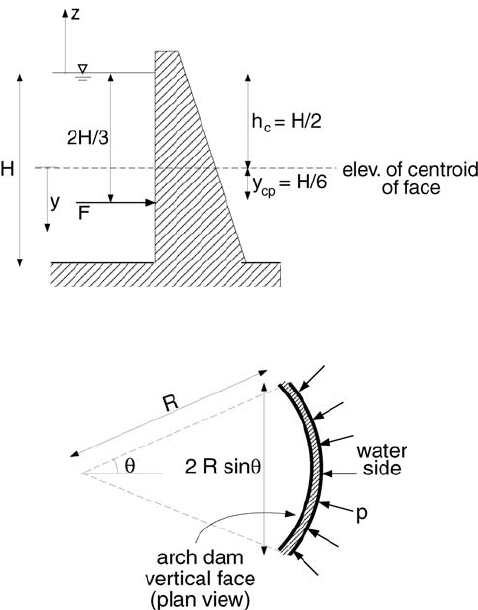
29-6 The Civil Engineering Handbook, Second Edition
Application 2: Force on an Arch Dam
Consider a constant radius arch-dam with a vertical upstream face (Fig. 29.5). What is the net horizontal
force acting on the dam face due to hydrostatic forces? The projected area is A
p
= (2R sin q) ¥ H, while
the pressure at the centroid of the projected surface is p
c
= gH/2. The magnitude of the horizontal force
is thus gRH
2
sin q, and the center of pressure lies (as in App. 1) 2H/3 below the water surface on the line
of symmetry of the dam face. Because the face is assumed vertical, the vertical force on the dam is zero.
Application 3: Force on a Tainter Gate
Consider a radial (Tainter) gate of radius R with angle q and width W (Fig. 29.6). What are the horizontal
and vertical forces acting on the gate? For the horizontal force computation, the area of the projected
surface is A
p
= (2R sin q) ¥ W, and the pressure at the centroid of the projected surface is p
c
= g(2R sin q)/2,
because the centroid is located at a depth of (2R sin q)/2. Hence, the magnitude of the horizontal force
is 2g(R sin q)W, and it acts at a distance 2(2R sin q)/3 below the water surface. The vertical force is the
sum of a downward force equal in magnitude to the weight of the fluid in the volume AB¢BA, and an
upward force equal in magnitude to the weight of the fluid in the volume, AB¢BCA. This equals in
magnitude the weight of the fluid in the volume, ABCA, namely, gWR
2
(q – sin q cos q), and acts upwards
through the center of gravity of this volume. Alternatively, because the gate is an arc of a circle, the
horizontal and vertical forces act through the center, O, and no net moment is created by the fluid forces.
Application 4: Archimedes’ Law of Buoyancy
Consider an arbitrarily shaped body of density, r
s
, submerged in a fluid of density, r (Fig. 29.7). What
is the net vertical force on the body due to hydrostatic forces? The net horizontal force is necessarily zero
FIGURE 29.4 Hydrostatic forces on a vertical dam face.
FIGURE 29.5 Hydrostatic forces on the face of a vertical arch dam.
© 2003 by CRC Press LLC
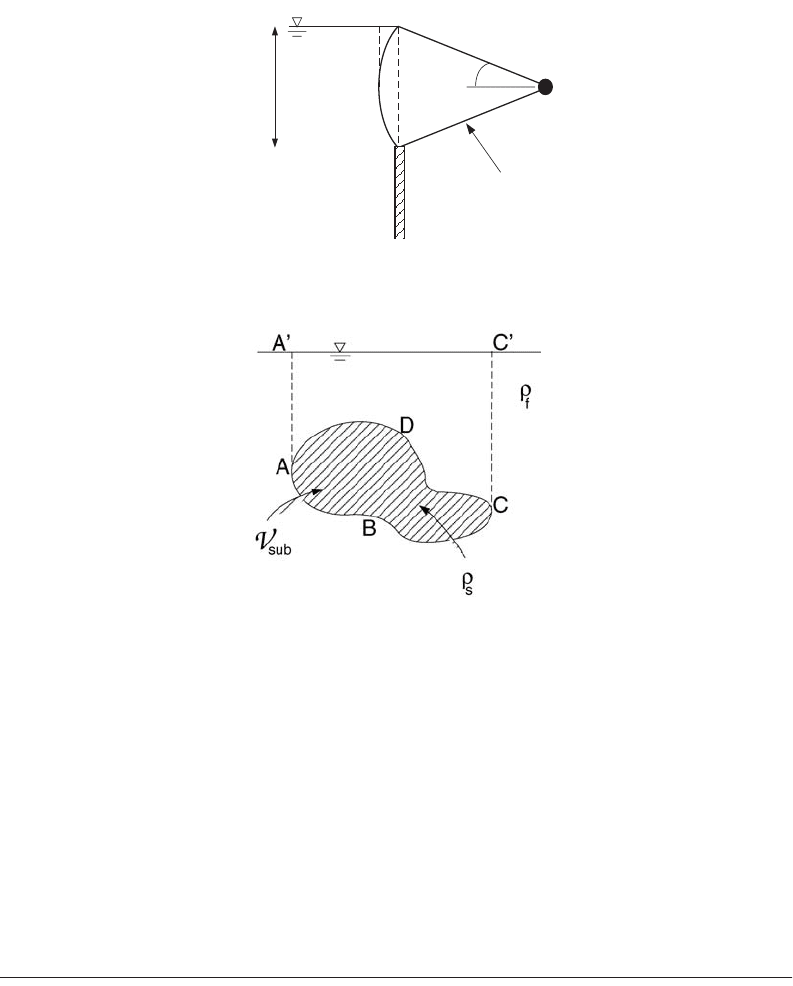
Fundamentals of Hydraulics 29-7
since the horizontal forces on projected surfaces are equal and opposite. The surface in contact with the
fluid and therefore exposed to the hydrostatic load is divided into an upper surface, marked by curve
ADC, and a lower surface, marked by curve ABC. The vertical force on ADC equals in magnitude the
weight of the fluid in the volume, ADCC¢A¢A, and acts downward since the vertical component of the
hydrostatic forces on this surface acts downward. The vertical force on ABC equals in magnitude the
weight of the fluid in the volume, ABCC¢A¢A, but this acts upward since the vertical component of the
hydrostatic forces on this surface acts upward. The vector sum, F
b
, of these vertical forces acts upward
through the center of gravity of the submerged volume, and equals in magnitude the weight of the fluid
volume displaced by the body, F
b
= rgV
sub
, where V
sub
is the submerged volume of the body. This result
is known as Archimedes’ principle. The effective weight of the body in the fluid is W
eff
= (r
s
– r) g V
sub
.
29.4 Fluids in Non-Uniform Motion
Description of Fluid Flow
A flow is described by the velocity vector, u(x, y, z, t) = (u, v, w), at a point in space, (x, y, z), and at a
given instant in time t. It is one-, two-, or three-dimensional if it varies only in one, two or three coordinate
directions. If flow characteristics do not vary in a given direction, the flow is said to be uniform in that
direction. Similarly, if flow characteristics at a point (or in a region of interest) do not vary with time,
it is termed steady; otherwise, it is unsteady. Although a flow may strictly speaking be unsteady and three-
dimensional, it can often for practical purposes be approximated or modeled as a steady one-dimensional
flow.
FIGURE 29.6 Hyrdrostatic forces on a radial (Tainter) gate.
FIGURE 29.7 Hydrostatic forces on a general submerged body.
R
θ
2 R sinθ
A
B
C
B’
hinge
Tainter
gate
© 2003 by CRC Press LLC

29-8 The Civil Engineering Handbook, Second Edition
A streamline is a line to which the velocity vectors are tangent, and thus indicates the instantaneous
direction of flow at each point on the streamline (see Fig. 29.8 for examples of streamlines). As such,
there can be no flow across streamlines; flow boundaries, such as a solid impervious boundary or the
free water surface, must therefore coincide with streamlines (actually stream surfaces). If an unsteady
flow is approximated as being steady, the concept of time-averaged streamlines corresponding to the
time-averaged velocity field is useful. A collection of streamlines can be used to give a picture of the
overall flow pattern. Streamlines should however be distinguished from streaklines. The latter are formed
when dye or particles are injected at a point into the flow, as is often done in flow visualization. While
streaklines and streamlines coincide in a strictly steady flow, they differ in an unsteady flow.
Qualitative Flow Features and Flow Classification
Broad classes of qualitatively similar flow phenomena may be distinguished. Laminar flows are charac-
terized by gradual and regular variations over time and space, with relatively little mixing occurring
between individual fluid elements. In contrast, turbulent flows are unsteady, with rapid and seemingly
random instantaneous variations in flow variables such as velocity or pressure over time and space. A
high degree of bulk mixing accompanies these fluctuations, with implications for transport of momentum
(fluid friction) and contaminants. In dealing with predominantly turbulent flows in practice, the hydrau-
lic engineer is concerned primarily with time-averaged characteristics.
Flow separation occurs when a streamline begins at a solid boundary (at the separation point) and
enters the region of flow (Fig. 29.8). This may happen when the solid boundary diverges sufficiently
sharply in the streamwise direction, and is associated with downstream recirculating regions (regions
with closed streamlines). The latter are sometimes termed dead-water zones, and their presence may
have important implications for mixing efficiency. In flows around bodies, flow separation creates a low-
pressure region immediately downstream of the body, termed the wake. The difference in pressure
upstream and downstream of the body may therefore contribute significantly to flow resistance (see
Section 29.8).
The Bernoulli Theorem
In the case of an ideal constant-density fluid moving in a gravitational field, a balance along a streamline
between inertial (acceleration), pressure and gravitational forces yields the Bernoulli theorem. This states
that, on a streamline,
(29.6)
where the integration is performed along the streamline, and u
s
is the magnitude of the velocity at any
point on the streamline. Equation (29.6) applies on a given streamline, and the ‘constant’ will in general
vary for different streamlines. The Bernoulli equation for steady flows (∂/∂t = 0) is usually expressed as
FIGURE 29.8 Examples of mean streamlines and flow separation
∂
∂
+++
Ê
Ë
Á
ˆ
¯
˜
=
Ú
u
t
ds
p
gz
u
ss
constant
r
2
2
© 2003 by CRC Press LLC
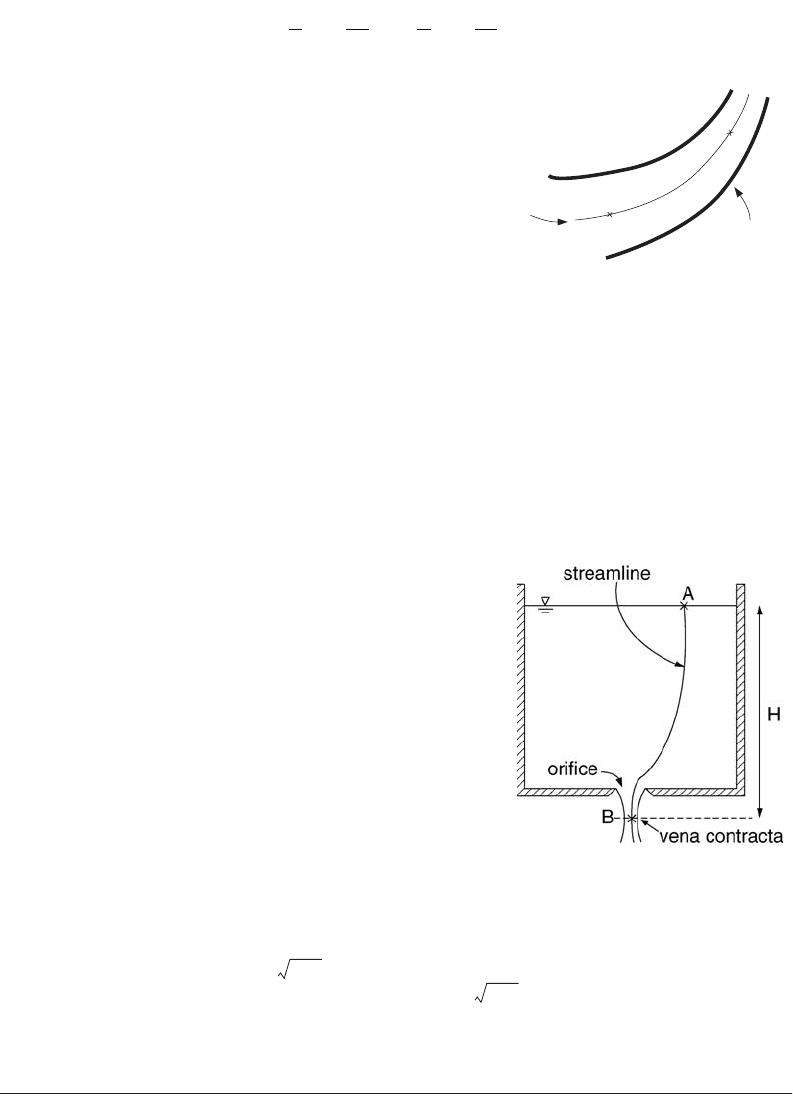
Fundamentals of Hydraulics 29-9
(29.7)
where the subscripts A and B indicate two points on the same
streamline along which the Bernoulli theorem is applied (Fig.
29.9). The quantity, (p/g) + z +(u
2
s
/2g), is termed the Bernoulli
constant. For steady uniform flows, (u
2
s
/2g)
A
=(u
2
s
/2g)
B
, and
Eq. (29.7) reduces to the equality of piezometric heads as
found before for hydrostatic conditions. The Bernoulli theo-
rem thus generalizes the hydrostatic result to account for the
non-uniformity or acceleration of the flow field by including
a possibly changing velocity head. The quantity, ru
2
s
/2 is some-
times termed the dynamic pressure (as distinct from the static
pressure, p, in Eq. [29.7]), and the sum, p + ru
2
s
/2, is termed
the total or stagnation pressure (stagnation, as this would be
the pressure if the fluid particle were brought to a stop).
The Bernoulli theorem provides information about variations along the streamline direction; in the
direction normal to the streamline, a similar force balance shows that the piezometric head is constant in
the direction normal to the streamline provided the flow is steady and parallel or nearly parallel. In other
words, hydrostatic conditions prevail at a flow cross-section in a direction normal to the nearly parallel
streamlines. This is implicitly assumed in much of hydraulics.
Application 5: An Orifice Flow
An orifice is a closed contour opening in a wall of a tank or in
a plate at a pipe cross-section. A simple example of flow through
an orifice from a large tank discharging into the atmosphere is
shown in Fig. 29.10. What is the exit velocity at (or near) the
orifice? The Bernoulli theorem is applied on a streamline
between a point A on the free surface and a point B at the vena
contracta of the orifice, the section at which the jet area is a
minimum. At the vena contracta, the streamlines are straight,
such that hydrostatic conditions prevail, and the piezometric
head in the fluid must be the same throughout that section. For
the situation shown, the elevation is the same over the section,
which implies that the pressure must be constant over the entire
section. Because the pressure on the surface of the jet is zero, the
pressure, p
B
= 0. Because the tank is open to the atmosphere,
p
A
= 0, and the tank is large, the velocity head in the tank,
(u
2
s
/2g)
A
, is negligible. Hence, (u
2
s
/2g)
B
= z
A
– z
B
= H, where H
is the elevation difference between the tank free surface and the vena contracta section. The exit velocity
at the vena contracta is given by u
s
= , a result also known as Torricelli’s theorem. The related result
that the discharge (see the definition in Section 29.5), Q µ A , where A is the area of the orifice,
arises also in discussions of culverts flowing full and other hydraulic structures.
29.5 Fundamental Conservation Laws
The analysis of flow problems is based on three main conservation laws, namely, the conservation of mass,
momentum, and energy. For most hydraulic problems, it suffices to formulate these laws in integral form
for one-dimensional flows to which the following is restricted. A systematic approach is based on the
analysis of a control volume, which is an imaginary volume bounded by control surfaces through which
p
z
u
g
p
z
u
g
s
A
s
B
gg
++
Ê
Ë
Á
ˆ
¯
˜
=++
Ê
Ë
Á
ˆ
¯
˜
22
22
FIGURE 29.9 Flow streamline along which
the Bernoulli theorem is applied.
A
B
streamline
curved conduit
or channel
FIGURE 29.10 Flow through an orifice
in the bottom of a large tank.
2gH
2gH
© 2003 by CRC Press LLC
